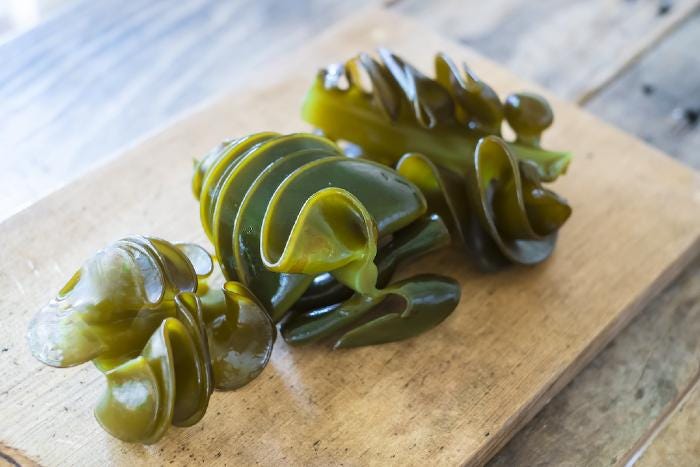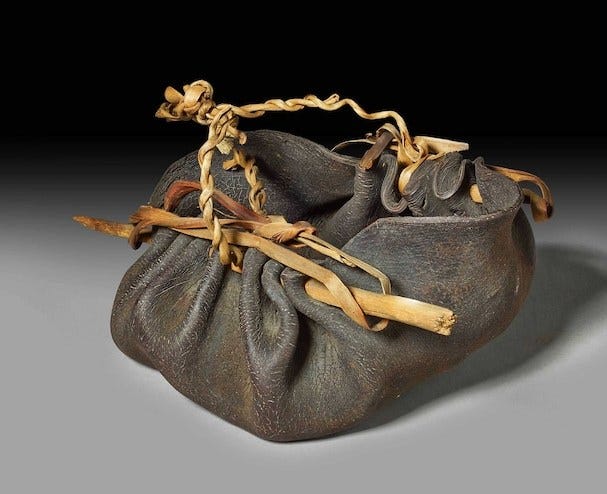Sea moss trending with Black Americans
Plus: biostimulants from Macrocystis & Sargassum, carbon science cools climate hopes
Are you a Black American? If you are anything like me, then, no. In that case, you might also be surprised to read that sea moss is a growing trend among Black Americans. But it definitely is, at least according to Alexiou Gibson, who got a 600,000 investment for his sea moss nutraceutical business after bringing in $3.5 million in revenue — including $1.4 million in profit — in just 11 months of business.
Sea moss is espoused by Black celebrities and trendy magazines, because it’s healthy on the one hand, but also because it is perceived as part of a Black culinary and cultural heritage, an uncolonized Black food.
With the Romantic focus on the “natural“ so typical of the wellness story, wild harvested (sorry, wildcrafted) seaweed is preferred, with people claiming their sea moss is “never pool- or farm-grown“.
Gibson’s Transformation Factory sources its sea moss from Jamaica, while many others are getting theirs from St Lucia. But Ireland and Tanzania are also sources. That gives rise to some confusion as these are obviously different species of seaweed: a type of Gracilaria from the Caribbean, Chondrus crispus from Ireland and Eucheuma denticulatum from Tanzania.
Pressured by a monopsony of carrageenan producers looking for the cheapest supply, tropical seaweed production has been under-invested in for decades. A pivot to higher-value markets would bring in the funds necessary to climate-proof future production. Nutraceuticals, in spite of some questionable marketing claims, could offer such a market.
But then producers in the tropics need to be able to pocket most of the profits themselves, instead of savvy entrepreneurs like Alexiou Gibson. Belize’s seaweed farmers understood that. Placencia’s seaweed shakes, tasty to both locals and tourists, are zero-mile, add to local food security and bring in more money than hydrocolloids.

Trials add arguments for biostimulants from Macrocystis, Sargassum
Ascophyllum nodosum, Laminaria hyperborea and Ecklonia maxima are the main species used for biostimulant extractions at the moment. Several companies are now pushing to add Macrocystis pyrifera (Giant Kelp) to this line-up. Primary Ocean is the first in the North American market with a commercial product; they recently came out with positive trials on strawberries.
Sargassum horneri is a major bloom-forming species in Korea and China. It’s a lot of biomass floating to shore and it needs to be valorized. However, instead of aiming for agriculture, Korean scientists have tested Sargassum extractions on Neopyropia yezoensis, in an attempt to climate-proof the production of this important Korean seaweed species. With positive results: certain extractions improved heat resilience and crop growth.
Over on the side of the established Asco producers, Acadian Seaplants found that applications of their biostimulant were beneficial for almond growers adapting to California’s water shortages, because of seaweed-induced gene regulation.
Finally, a two million euro grant will be used to find out if seaweed extracts can help potato and carrot farmers adapt to the increasingly salty soils of The Netherlands as sea levels continue to rise. Another question to be answered: can potatoes with a seaweed coating produce low-carb fries?

New carbon science cools down climate hopes
New biological carbon pump research in the North Atlantic finds that for exported carbon remineralized at 1000m, which is often used as a sequestration horizon for long-term (100-1000s yrs) storage, only 66% remains sequestered for 100 years.
The authors conclude that this has implications for the accuracy of future carbon sequestration estimates, which may be overstated, but also for ocean carbon dioxide removal + Blue Carbon schemes that require long-term sequestration to be successful.
Other papers of note
Can pumping nutrient-rich water from the deep ocean to the surface (artificial upwelling) draw down significant amounts of CO2 through micro- or macroalgae growth? No.
What are the potential negative effects of ocean afforestation on offshore ecosystems? No idea, the article is not available on Sci-hub yet. But we should be mindful of it, the authors warn.
How to operationalize the blue carbon market? A new McKinsey report on blue carbon has some additional graphs of interest.
Investigating the carbon productivity of 3 seaweed farms and comparing them to wild populations in Japan.
A string of scientists have left Running Tide in recent months
Mentioned in an earlier newsletter but now finally published:
A rebuttal to the Gallagher paper that wrote seaweed forests could be emitters, not carbon sinks.
Global seaweed distribution: seaweed habitats equal the Amazon rainforest in terms of both area and productivity and should be included in global C budgets.

Investment news in brief
1 million euros in seed funding from French business angels for Neptune Elements to accelerate the growth of their range of seaweed seasonings.
After last month’s $7 million for Symbrosia, this month Blue Ocean Barns received $20 million in Series A funding to expand their tank-based Asparagopsis cultivation for ruminant methane reduction




Do you know where in the Caribbean he sources his seaweed?
Great links in here, Steven. Thanks, as always.